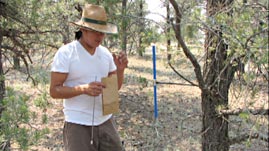Teachers' Domain - Digital Media for the Classroom and Professional Development
User: Preview

Source: A Navajo Technical College production for NASA's Where Words Touch the Earth.



In this video segment adapted from Navajo Technical College, meet Steven Chischilly, a professor of environmental science, and hear about his research on climate change. Listen as he describes how climatic conditions, such as moisture and precipitation, contribute to tree growth rates and the amount of carbon that is stored by a tree in different years. Learn about dendroclimatology—the study of the relationship between climate and the annual growth rings of trees—and how he is correlating historical weather station data about the Navajo Nation with growth rings.
Dendrochronology, or tree-ring dating, is the study of annual growth rings in trees to determine the age of a tree. Annual growth rings appear as alternating bands of lighter and darker rings in the horizontal cross section of a tree trunk. Each year, a tree grows in diameter as it produces a new layer of wood cells. The rings form as a result of the change in speed of growth throughout the year: a tree grows relatively rapidly during the early part of its growing season, which produces lighter-colored cells (called earlywood), and more slowly during the later part of the growing season, which produces darker, denser cells (called latewood). One ring begins at the inner edge of the earlywood and ends at the outer edge of the latewood. Favorable growing conditions usually result in a wider ring, and less favorable conditions produce a narrower ring. Trees typically form one ring a year, although certain conditions can produce more than one ring in a given year or none at all.
Because the rate of tree growth depends on environmental conditions (such as sunlight, temperature, precipitation, humidity, and wind), growth rings can help researchers determine the age of wood and learn about past climates. In some areas, a growth ring from certain tree species can be correlated to a particular calendar year. The patterns of rings create a chronology, or record of time, and can be matched with other trees to build a more complete history. Most individual trees live less than a few hundred years, but a tree-ring chronology built from the analysis of many trees in a region can go back thousands of years.
In addition to climate conditions, there are many other factors that can affect the rate of tree growth, such as soil, other trees, genetic differences, impacts from humans or pests, disease, fire, volcanic eruptions, and the amount of carbon dioxide in the atmosphere. A wider ring could be explained by several factors, including ample water and sunlight or more nutrients (more carbon dioxide in the atmosphere, for example), so scientists must examine many trees from a region in their effort to understand which environmental factors best explain shared characteristic growth patterns. Scientists attempt to separate out a single factor to study by looking at trees in certain areas where they are most sensitive to a particular factor. Because tree growth in dry regions is largely limited by moisture availability, dry regions such as the southwestern U.S., including the lands of the Navajo Nation, are well suited for studies of dendroclimatology. Steven Chischilly, the scientist featured in the video, has been studying pinyon pines in the southwestern U.S. to look for correlations between the growth rings and changes in climate.
 Loading Standards
Loading Standards